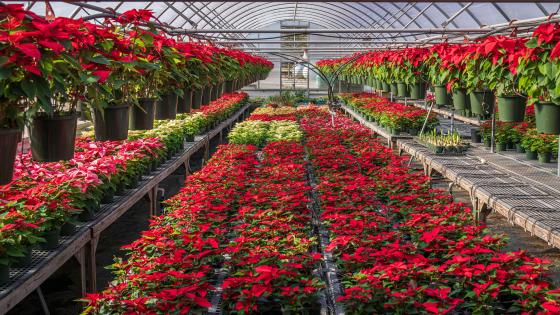
Poinsettias
Poinsettias
Poinsettias (Euphorbia pulcherrima) are subtropical plants that originated in Mexico and Guatemala. In their native climate, poinsettias are small woody shrubs that may reach a height of more than 10 feet. In most of the U.S., poinsettias are grown as indoor potted plants popular at Christmas time. While the showy bracts are suggestive of flower petals, they are really modified leaves. The actual poinsettia flowers are less conspicuous by comparison, forming a yellow to red cluster in the center of the bracts.
Key Requirements
| Land | Low |
| Labor | High |
| Capital | High |
Take the HortBizQuiz to see how much Land, Labor, and Capital you have for your operation.
Markets
- Direct to Consumer
- Farmer's Market
- On-Farm
- Florists
Pests & Disease
Potential disease problems include Rhizoctonia root and stem rot, Pythium root rot, Thielaviopsis black root rot, Botrytis blight and bacterial soft rot. Regular preventative fungicide drenches in combination with good sanitation and cultural practices are essential to controlling poinsettia diseases. Common insect pests include whiteflies, thrips, fungus gnats, shoreflies and spider mites. Using yellow sticky cards to monitor insect populations can help growers determine when and how often insecticides should be applied.
Costs and returns are presented as estimates. They will vary based on your farm and markets.
Costs and returns are presented as estimates. They will vary based on your farm and markets.
Challenges
- A heated greenhouse structure is necessary for poinsettia production.
- Poinsettia production is a high risk business with significant start up costs as well as demanding labor and management.
Opportunities
Growers who produce multiple varieties will have the market advantage.